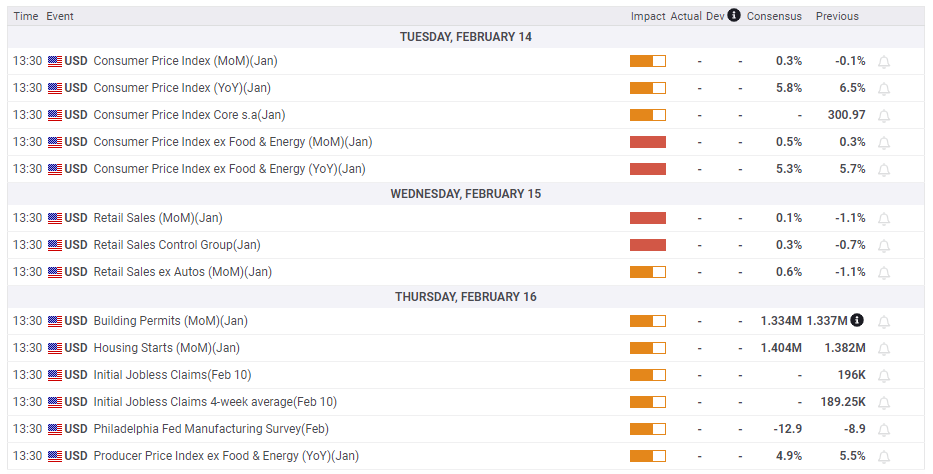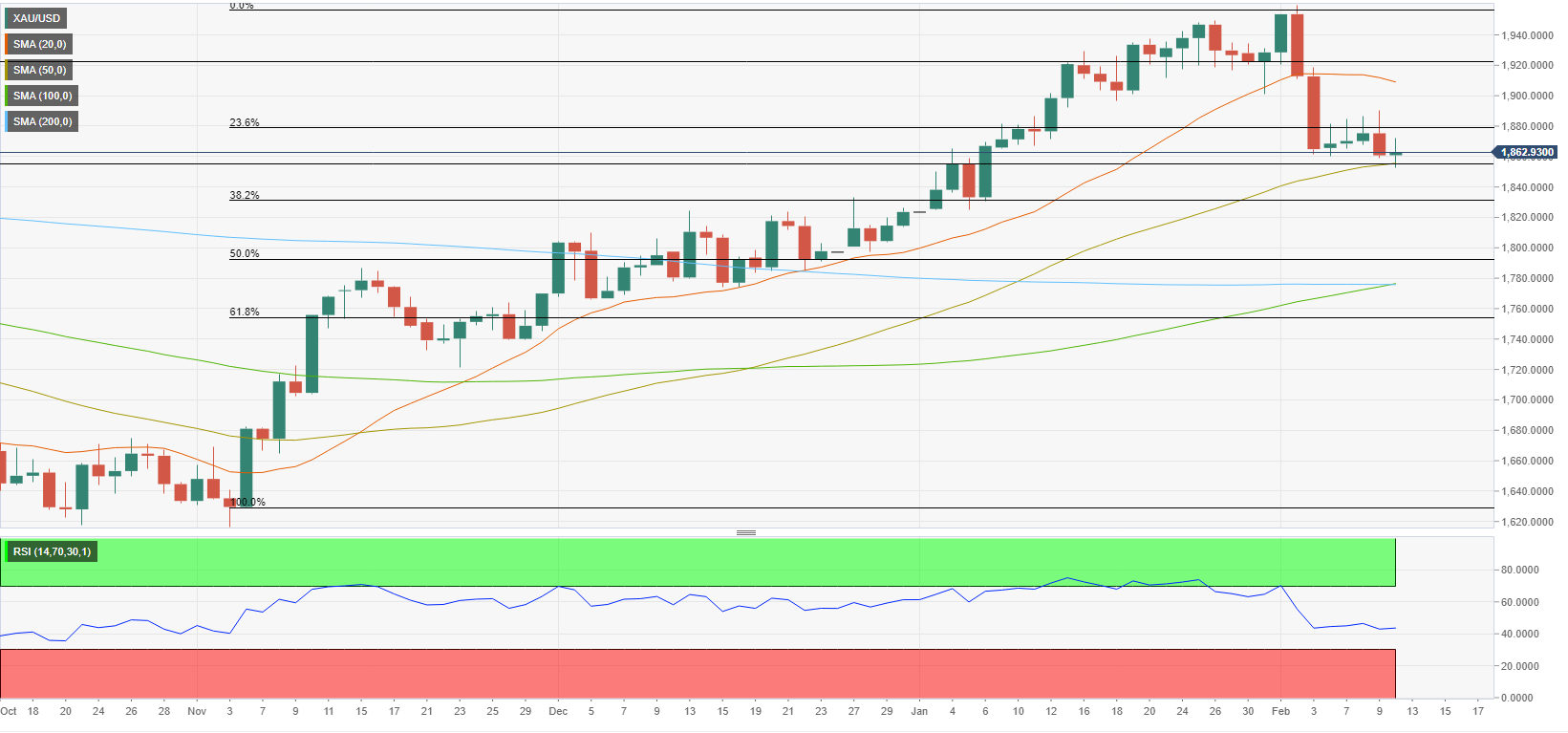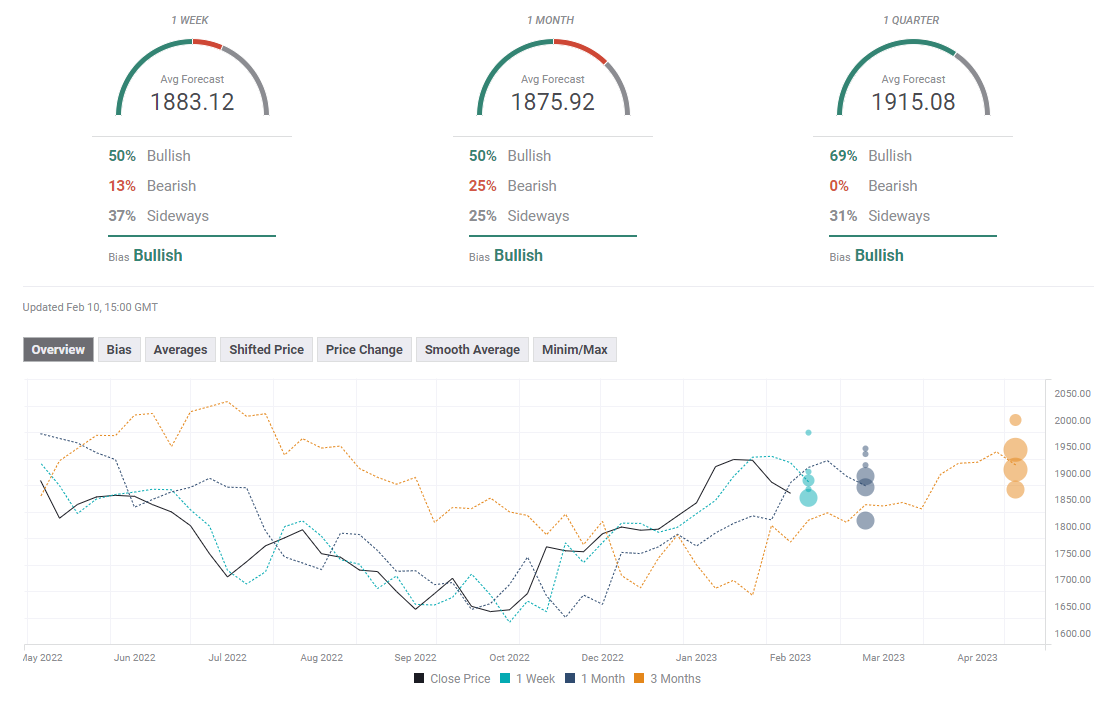- Gold price struggled to make a decisive move in either direction.
- XAU/USD is likely to face strong resistance at $1,880.
- January inflation data from the US could trigger a significant reaction in the pair.
Gold price started the new week in a calm manner but managed to post three straight daily gains before losing its traction on Thursday amid the action in the US Treasury bond yields. Nevertheless, XAU/USD ended the week virtually unchanged at around $1,860. The highly-anticipated inflation data from the US could influence the market pricing of the Federal Reserve’s (Fed) rate outlook and provide a directional clue to the pair next week.
What happened last week?
In the absence of high-tier macroeconomic data releases, XAU/USD fluctuated in a tight range on Monday but short-covering following the sharp decline witnessed ahead of the weekend allowed the pair to make a technical correction.
On Tuesday, hawkish Fed commentary helped the US Dollar stay resilient against its rivals and limited XAU/USD’s upside. Minneapolis Fed President Neel Kashkari noted that his terminal rate projection was still around 5.4% following the impressive January jobs report and noted that they haven’t yet made enough progress to declare victory in the battle against inflation.
In an interview with The Economic Club of Washington, D.C., “we probably need to do further interest rate increases,” FOMC Chairman Jerome Powell noted. The Chairman also acknowledged that they expect 2023 to be a year of significant declines in inflation. The CME Group FedWatch Tool’s probability of two more 25 basis points (bps) rate hikes in March and May stood around 70%, suggesting that these comments failed to influence the market pricing of the Fed rate outlook.
Following Wednesday’s indecisive action, XAU/USD came under bearish pressure late Thursday and erased all of its weekly gains. As the US 10-year and the US T-bond yield curve inversion continued to deepen, safe-haven flows dominated the markets and Gold price registered its lowest daily close in a month slightly below $1,860, losing nearly 1% on the day.
Meanwhile, New York Fed President John Williams noted that a peak rate of 5%-5.25% was still a reasonable view and Richmond Fed President Thomas Barkin said that data continue to push back recession risks, allowing hawkish Fed bets to lift yields.
Finally, the monthly data published by the University of Michigan revealed on Friday that the Consumer Confidence Index rose to 66.4 in February's flash estimate from 65 in January. Additionally, the year-ahead inflation expectations component rebounded to 4.2% from 3.9% in January and helped the USD hold its ground ahead of the weekend.
Next week
The US Bureau of Economic Analysis (BEA) will publish the January inflation report on Tuesday and the market action is likely to remain subdued ahead of this event.
The Consumer Price Index (CPI) is forecast to decline to 5.8% on a yearly basis from 6.5% in December. The Core CPI, which excludes volatile food and energy prices, is projected to decline to 5.3% from 5.7%. Since base effects are likely to distort annual readings, market participants are likely to react to the monthly Core CPI, which is forecast to rise by 0.5% following December’s 0.4% increase.
The market positioning, as mentioned above, suggests that there is more room on the upside for the US Dollar in case the monthly Core CPI prints a stronger-than-expected increase in January. On the other hand, a print at or below 0.3% could revive the ‘Fed pivot’ narrative and provide a boost to XAU/USD by weighing heavily on the US Dollar and the US T-bond yields.
In December, the ‘services less energy services’ component of the CPI came in at +0.5%. Since this is the specific component of inflation that the Fed pays close attention to, a big increase in January, around 0.7% or 0.8%, could provide a boost to the US Dollar even if the Core CPI comes in near the market expectation and vice versa.
On Wednesday, January Retail Sales will be featured in the US economic docket but it’s unlikely to trigger a noticeable market reaction. On Thursday, January Housing Starts and Building Permits will be looked upon for fresh impetus. The real estate market has been struggling with rising interest rates weighing on demand. Housing Starts are forecast to rebound and rise by 0.6% following December’s contraction of 1.4%. A negative print could hurt the US Dollar while an unexpected increase could have the opposite impact but the market reaction to this data should remain short-lived.
In the meantime, comments from Fed officials will be watched closely by market participants after the inflation data. The reaction in the bond market could provide a directional clue to XAU/USD due to the pair’s inverse correlation with yields, especially the 10-year reference.
Gold price technical analysis
XAU/USD near-term technical picture points to a neutral/bearish bias. The Relative Strength Index (RSI) indicator on the daily chart moves sideways slightly below 50 but the 50-day Simple Moving Average (SMA) stays intact at around $1,855.
A daily close below $1,855 could bring in additional sellers and open the door for an extended slide toward $1,830 (Fibonacci 38.2% retracement level of the latest uptrend). In case the latter support fails and starts acting as resistance, Gold price could stretch lower toward $1,800.
On the upside, $1,880 (Fibonacci 23.6% retracement) aligns as key support ahead of $1,900/$1,905 (psychological level, 20-day SMA). Once the pair clears that second hurdle, it could aim for $1,920 (static level, former support).
Gold price forecast poll
The FXStreet Forecast poll points to a slightly bullish bias in the one-week outlook with the average target sitting at $1,883. Half of the polled experts expect XAU/USD to continue to rise over the next four weeks and four months.
Information on these pages contains forward-looking statements that involve risks and uncertainties. Markets and instruments profiled on this page are for informational purposes only and should not in any way come across as a recommendation to buy or sell in these assets. You should do your own thorough research before making any investment decisions. FXStreet does not in any way guarantee that this information is free from mistakes, errors, or material misstatements. It also does not guarantee that this information is of a timely nature. Investing in Open Markets involves a great deal of risk, including the loss of all or a portion of your investment, as well as emotional distress. All risks, losses and costs associated with investing, including total loss of principal, are your responsibility. The views and opinions expressed in this article are those of the authors and do not necessarily reflect the official policy or position of FXStreet nor its advertisers. The author will not be held responsible for information that is found at the end of links posted on this page.
If not otherwise explicitly mentioned in the body of the article, at the time of writing, the author has no position in any stock mentioned in this article and no business relationship with any company mentioned. The author has not received compensation for writing this article, other than from FXStreet.
FXStreet and the author do not provide personalized recommendations. The author makes no representations as to the accuracy, completeness, or suitability of this information. FXStreet and the author will not be liable for any errors, omissions or any losses, injuries or damages arising from this information and its display or use. Errors and omissions excepted.
The author and FXStreet are not registered investment advisors and nothing in this article is intended to be investment advice.
Recommended Content
Editors’ Picks

Gold retreats from record highs at $3,220 ahead of US data
Gold price is retreating from fresh all-time highs of $3,220 in early Europe on Friday. The US Dollar downward spiral and escalating trade war between the United States and China continue to underpin the safe-haven appeal of Gold price. US PPI inflation data and tariff updates remain on tap.

EUR/USD consolidates weekly gains near 1.1250 ahead of Lagarde's speech
EUR/USD is consolidating the uptick to three-year highs of 1.1385 in Friday's European session. The pait stays supported amid easing US-EU trade tensions and broad US Dollar weakness. Tarff talks will be closely eyed alongside Lagarde's speech and US data.

GBP/USD holds gains near 1.3000 after UK data
GBP/USD is paring back gains to near 1.3000 in Friday’s early European session. The pair stays firm as the US Dollar loses ground amid lingering concerns over US economic growth and US-China trade war. Upbeat UK economic data fail to impress the Pound Sterling.

Bitcoin, Ethereum and Ripple show weakness while XRP stabilizes
Bitcoin and Ethereum prices are hovering around $80,000 and $1,500 on Friday after facing rejection from their respective key levels, indicating signs of weakness. Meanwhile, Ripple broke and found support around its critical level; maintenance suggests a recovery on the cards.

Trump’s tariff pause sparks rally – What comes next?
Markets staged a dramatic reversal Wednesday, led by a 12% surge in the Nasdaq and strong gains across major indices, following President Trump’s unexpected decision to pause tariff escalation for non-retaliating trade partners.

The Best brokers to trade EUR/USD
SPONSORED Discover the top brokers for trading EUR/USD in 2025. Our list features brokers with competitive spreads, fast execution, and powerful platforms. Whether you're a beginner or an expert, find the right partner to navigate the dynamic Forex market.


